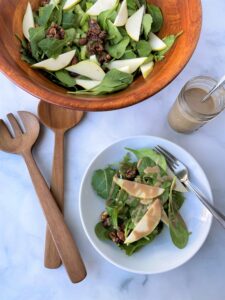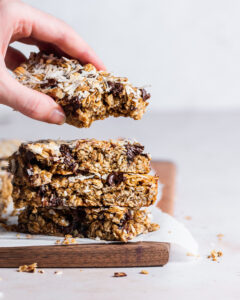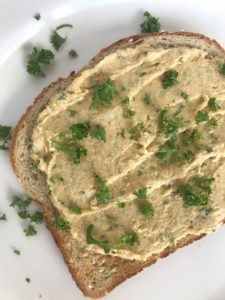A Beginner’s Guide to Plant Forward Eating
It’s officially Vegetarian Month! Before you clutch everything in your cheese drawer and run for the hills, let us remind you that we won’t tell you how to live your life nor what a healthy lifestyle looks like for you. Today we are exploring what it means to live a plant forward lifestyle — whether you include animal products or not!
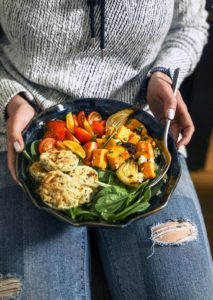
There are so many messages out there about plant based alternatives and how to make plants as an important part of your life. Our goal is to cut through all the confusion and offer digestible tidbits of information to help you make the best decisions for you and your family.
Table of Contents
ToggleTraditional Meal Structure
Western Culture has trained many of us to believe that an acceptable meal structure is made of a protein, typically meat or poultry, and a couple sides. These sides are often vegetables, grains, and some sort of bread. These ideas can be very limiting for those of us who may not have the time, expertise, or resources to prepare a multi-course meal one to three times a day.
By letting go of this classic meal structure, we open ourselves to eat a wider variety of foods, at “non-traditional” meal or snack times, and escape the shame of not having “balanced” meals. There are plenty of ways to fuel your body that do not require subscribing to this structure and you may even find you are able to eat in a way that feels less demanding and more satisfying than before.
Should I Go Vegetarian/Vegan?
Your meal patterns should be rooted in your core principles, preferences, and your doctor’s recommendations. However, you don’t have to go vegetarian or vegan to live a plant-forward lifestyle.
Why Live Plant Forward
Variety
By intentionally increasing your intake of plant products, you will be naturally directed to try new things. This approach encourages you to get creative — and the more types of foods you eat, the more diverse the nutrients you eat. You may also discover new flavors and textures that you may have never discovered if you didn’t get out of your food comfort zone.
Try out new flavors and textures by trying out one of our recipes!
Fiber
Fruits, veggies, grains, and beans — whether raw, cooked, canned, or frozen — are great sources of both soluble and insoluble fiber. Fiber can promote gut health and lower cholesterol. It can also increase your satiety so you can be more in touch with your natural hunger and fullness cues.
You can learn more about the importance of fiber here!
Long Shelf Life
When you think of plant-based products, you may think of produce! Don’t forget about the many plant-based ingredients that are frozen or canned. This makes it extremely simple to whip together a quick meal without an extra trip to the store! You’d be surprised at all the ways you could use a can of beans or a jar of nuts! By keeping cans of tomatoes, corn, or beans on hands, you will always have the makings for a quick sauce or soup, any time of the year!
Check out this post for more ideas of quick meals with pantry-staples!
Save Time and Money
Don’t forget to make the most of the frozen section! You may be surprised just how many common produce items are available in a frozen, prepared version. From spinach, to sweet potatoes, edamame to corn, stocking up on frozen veggies makes it easier than ever to add them to any meal. This can also help you buy in bulk to save on paying for extra packaging. Frozen fruits and veggies are often flash frozen very close to harvest. This preserves both their freshness and nutritional value. Sure, freezing and cooking can alter nutritional profiles slightly. However, cooking certain veggies can even help your body absorb more nutrients from the food.
Find more ways to make delicious, quick meals here!
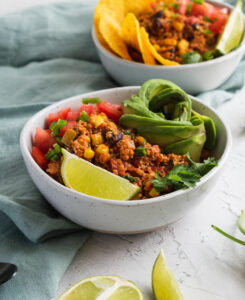
How to Add in Plants
- Use easy, shelf stable alternatives: Replace eggs in a recipe with flax eggs using Manitoba Milling Co. Smooth Whole-Milled Flaxseed
- Make a quick, fresh pesto — add to pasta, sandwiches, pizza, etc.
- Try fermented foods for a punch of flavor and probiotics
- Add veggies into meals you are already used to preparing.
- Ex. bell peppers and corn into burritos or quesadillas
- Experiment with growing your own fruits, veggies, and herbs
- Give Meatless Monday a try
- Try one of these plant-forward recipes
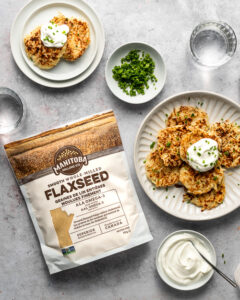
In summary, plant forward eating can look very different from more traditional vegan and vegetarian styles. Adding in more plants to your routine doesn’t need to be a way to avoid animal products if you don’t want to. If you’d like to still include animal products in your meals, think about it from the perspective of adding more fruits, vegetables, and plant products into what you eat — not necessarily restricting animal products. You may find that simply by shifting your mindset around plants, you can reap the benefits of a wide variety of vitamins, minerals, and nutrients packed into each fruit and veggie.
If you’re considering a plant-based lifestyle, check out the nutrients you should pay attention to here!
What’s your favorite way to add vitamins and minerals to your meals and snacks? Snap a photo and tag us @manitobamilling for a chance to be featured!

